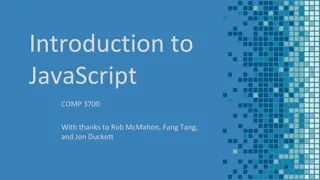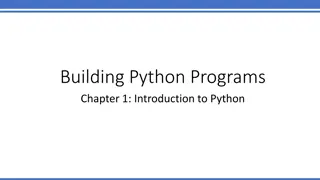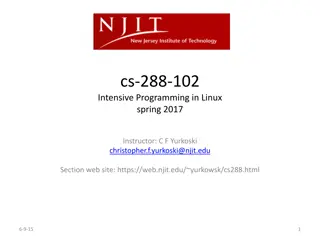Understanding Functional Programming Paradigm
Functional programming emphasizes well-structured software that is easy to write and debug, with reusable modules to reduce future programming costs. It introduces higher-order functions and first-class function values, fostering declarative programming for tasks like symbolic data manipulation and artificial intelligence. Functional programming languages use simple syntax, garbage collection, and polymorphism, making them suitable for various applications.
- Functional Programming
- Declarative Paradigm
- Higher-Order Functions
- Reusability
- Symbolic Manipulation
Download Presentation

Please find below an Image/Link to download the presentation.
The content on the website is provided AS IS for your information and personal use only. It may not be sold, licensed, or shared on other websites without obtaining consent from the author. Download presentation by click this link. If you encounter any issues during the download, it is possible that the publisher has removed the file from their server.
E N D
Presentation Transcript
Functional Programming As software becomes more and more complex, it is more and more important to structure it well. Well-structured software is easy to write and to debug, and provides a collection of modules that can be reused to reduce future programming costs. Map-Reduce has its roots in functional programming, which is exampled in languages such as Lisp and ML.
Functional Programming Examples // Regular Style Integer timesTwo(Integer i) { return i * 2; } // Functional Style F<Integer, Integer> timesTwo = new F<Integer, Integer>() { public Integer f(Integer i) { return i * 2; } }
Functional Programming A key feature of functional languages is the concept of higher order functions, or functions that can accept other functions as arguments. // Regular Style List<Integer> oneUp = new ArrayList<Integer>(); for (Integer i: ints) oneUp.add(plusOne(i)); // Functional Style List<Integer> oneUp = ints.map(plusOne);
Functional Programming Two common built-in higher order functions are map and fold.
First class Function First-class function values: the ability of functions to return newly constructed functions F<Integer, Integer> timesTwo = new F<Integer, Integer>() { public Integer f(Integer i) { return i * 2; } }
Functional Programming Functional programming is a declarative programming paradigm Computation is more implicit (suggested but not communicated directly ) and functional call is the only form of explicit control Many (commercial) applications exist for functional programming: Symbolic data manipulation Natural language processing Artificial intelligence Automatic theorem proving and computer algebra Algorithmic optimization of programs written in pure functional languages (e.g Map-reduce)
Functional programming languages are Compiled and/or interpreted Have simple syntax Use garbage collection for memory management Are statically scoped or dynamically scoped Use higher-order functions and subroutine closures Use first-class function values Depend heavily on polymorphism
Origin of Functional Programming Church s thesis: All models of computation are equally powerful and can compute any function Turing s model of computation: Turing machine Reading/writing of values on an infinite tape by a finite state machine Church s model of computation: lambda calculus This inspired functional programming as a concrete implementation of lambda calculus. Computability theory: A program can be viewed as a constructive proof that some mathematical object with a desired property exists A function is a mapping from inputs to output objects and computes output objects from appropriate inputs
Concepts of Functional Programming Functional programming defines the outputs of a program as mathematical function of the inputs with no notion of internal state (no side effects ) A pure function can always be counted on to return the same results for the same input parameters No assignments: dangling and/or uninitialized pointer references do not occur Example pure functional programming languages: Miranda , Haskell , and Sisal Non-pure functional programming languages include imperative features with side effects that affect global state (e.g. through destructive assignments to global variables) Example: Lisp , Scheme , and ML.
Useful features in functional languages Useful features are found in functional languages that are often missing in imperative languages: First-class function values: the ability of functions to return newly constructed functions Higher-order functions: functions that take other functions as input parameters or return functions. Polymorphism: the ability to write functions that operate on more than one type of data. constructsfor constructing structured objects: the ability to specify a structured object in-line, e.g. a complete list or record value. Garbage collection for memory management.
LISP Lisp Lisp (LIST Processing language) was the original functional language Lisp and dialects are still the most widely used Simple and elegant design of Lisp: Homogeneityof programs and data: a Lisp program is a list and can be manipulated in Lisp as a list. Self-definition: a Lisp interpreter can be written in Lisp Interactive: interaction with user through "read-eval-print loop
Data Structures LISP & Scheme The only data structures in Lisp and Scheme are atoms and lists Atoms are: Numbers, e.g. 7 Strings, e.g. "abc" Identifier Names (variables), e.g. x Boolean values true #t and false #f Symbols which are quoted identifiers which will not be evaluated, e.g. y Input: a Output: Error: unbound variable a Input: a Output: a
Data Structures Lists: To distinguish list data structures from expressions that are written as lists, a quote ( ) is used to quote the list: (elt1 elt2 elt3 ...) Input: (3 4 5) Output: (3 4 5) Input: (a 6 (x y) "s") Output: (a 6 (x y) "s") Input: (a (+ 3 4)) Output: (a (+ 3 4)) Input: () Output: () -------------------------Empty list
Primitive List Operations car returns the head (first element) of a list Input: (car (2 3 4)) Output: 2 cdr (pronounced "coulder") returns the tail of a list (list without the head) Input: (cdr (2 3 4)) Output: (3 4) cons joins an element and a list to construct a new list Input: (cons 2 (3 4)) Output: (2 3 4) Examples: Input: (car (2)) Output: 2 Input: (car ()) Output: Error Input: (cdr (2 3)) Output: (3) Input: (cdr (cdr (2 3 4))) Output: (4) Input: (cdr (2)) Output: () Input: (cons 2 ()) Output: (2)
If-Then-Else Special forms resemble functions but have special evaluation rules A conditional expression in Scheme is written using the if special form: (if condition thenexpr elseexpr) Input: (if #t 1 2) Output: 1 Input: (if #f 1 "a") Output: "a Input: (if (> 1 2) "yes" "no") Output: "no" A more general if-then-else can be written using the cond special form: where the condition value pairs is a list of (cond value) pairs and the condition of the last pair can be else to return a default value Input: (cond ((< 1 2) 1) ((>= 1 2) 2)) Output: 1 Input: (cond ((< 2 1) 1) ((= 2 1) 2) (else 3)) Output: 3
Lambda Abstraction A Scheme lambda abstraction is a nameless function specified with the lambda special form: (lambda formal-parameters function-body) where the formal parameters are the function inputs and the function body is an expression that is the resulting value of the function Examples: (lambda (x) (* x x)) ; is a squaring function: x2 (lambda (a b) (sqrt (+ (* a a) (* b b)))) ; is a function:
Defining Global Functions in Scheme A function is globally defined using the define special form: (define name function) For example: (define sqr (lambda (x) (* x x)) ) Input: (sqr 3) Output: 9 Input: (sqr (sqr 3)) Output: 81 (define hypot (lambda (a b) (sqrt (+ (* a a) (* b b))))) Input: (hypot 3 4) Output: 5
I/O and Sequencing display prints a value Input: (display "Hello World!") Output: "Hello World!" Input: (display (+ 2 3)) Output: 5 newline advances to a new line Input: (newline) Example: (begin (display "Hello World!") (newline) (end) ) read-evaluate-print
Higher-Order Functions A function is called a higher-order function (also called a functional form) if it takes a function as an argument or returns a newly constructed function as a result. Scheme has several built-in higher-order functions, for example: apply takes a function and a list and applies the function with the elements of the list as arguments Input: (apply + (3 4)) Output: 7 Input: (apply (lambda (x) (* x x)) (3)) Output: 9 map takes a function and a list and returns a list after applying the function to each element of the list Input: (map (lambda (x) (* x x)) (1 2 3 4)) Output: (1 4 9 16) Here is a function that applies a function to an argument twice: (define twice (lambda (f n) (f (f n)))) Input: (twice sqrt 81) Output: 3 Input (fill 3 a ) output ( a a a )
Functional Programming Today Significant improvements in theory and practice of functional programming have been made in recent years Strongly typed (with type inference) Modular Imperative language features that are automatically translated to functional constructs (e.g. loops by recursion ) Improved efficiency Remaining obstacles to functional programming: Social: most programmers are trained in imperative programming Commercial: not many libraries, not very portable, and no integrated development environments for functional languages
Assignment What are the Beauties of functional programming?



![[PDF⚡READ❤ONLINE] Black Hole Astrophysics: The Engine Paradigm (Springer Praxis](/thumb/21503/pdf-read-online-black-hole-astrophysics-the-engine-paradigm-springer-praxis.jpg)



















